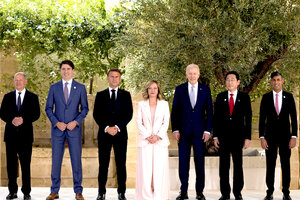A diverse roster of female leaders
As more women lead countries, attitudes shift on what qualities they bring to governing.

Host of the G7 Summit, Italian Prime Minister Giorgia Meloni, center, stands with German Chancellor Olaf Scholz, Canada's Prime Minister Justin Trudeau, French President Emmanuel Macron, U.S. President Joe Biden, Japan's Prime Minister Fumio Kishida, and Britain's Prime Minister Rishi Sunak.
AP
Twenty-nine countries now have female heads of state, which provides a fresh opportunity for a more varied view of how women might lead differently, if at all. One who has been in office for nearly two years in Europe, Italian Prime Minister Giorgia Meloni, on Thursday convened a summit of G7 leading industrialized nations in Puglia, Italy. A newcomer on the scene is Claudia Sheinbaum Pardo, winner of Mexico’s June 2 presidential election.
Although Dr. Sheinbaum won’t take office until October, she is offering clues on her leadership style, listening to citizens about their concerns from crime to education. She offers responses calmly, often with data on solutions. She flies commercial to save public money.
“She has a certain maternal part, like care, but at the same time she makes it very clear that her decisions are made by her, without having to say it,” Renata Turrent, an economist and adviser, told El País. “She navigates those two things in a very graceful way, like a dancer.”
Descriptions like that might make some people wince. Women in politics, business, or academia frequently face obstacles that originate in stereotypes. Take, for instance, cases of women who rely on a conciliatory approach with a foreign adversary. In a paper published in International Studies Quarterly last fall, researchers at Princeton and Carnegie Mellon universities found such women are viewed as acting “according to type,” while a man – pursuing the same sort of diplomacy – is seen as acting in the national interest.
Still, a shift in such social attitudes may also be underway. A study of the pandemic responses of 14 female heads of state, published in the International Journal of Environmental Research and Public Health, found that these leaders “challenged deeply ingrained cultural norms and beliefs about women’s capabilities.” Their success wasn’t based on qualities typically cast as feminine – but came through “decisive and timely action, clear communication, and risk-averse decision-making.”
Those attributes may now shape debates about European security at the G7 summit. Once dismissed as a hard-right populist, Ms. Meloni has gained a reputation among her peers for pragmatism. One convert is the head of the 55-nation African Union, Moussa Faki Mahamat. He has praised the Italian prime minister for seeking solutions to mass migration through Africa that transform “the vast regions of poverty, exclusion and human suffering into a space of prosperity and development” through partnership.
In her own way, Dr. Sheinbaum, a climate scientist and longtime leftist, takes a similar approach. As a student activist leader challenging attempts to privatize public education, she exhorted her peers to seek constructive dialogue. “Let’s not fall into provocations,” she urged.
“Women bring another dimension to leadership,” Ellen Johnson Sirleaf, former president of Liberia and the first female head of state in Africa, told Time recently. “They settle conflict rather than fight to resolve it. That does not take away from the application of the strength of authority when required, but when they can find an alternative route to peace, they seek it.”
A true picture of female leadership, free of stereotypes, may be emerging as more countries and businesses elevate women to higher roles. In the meantime, examples from Mexico to Italy help expand the picture of what is possible for all.

